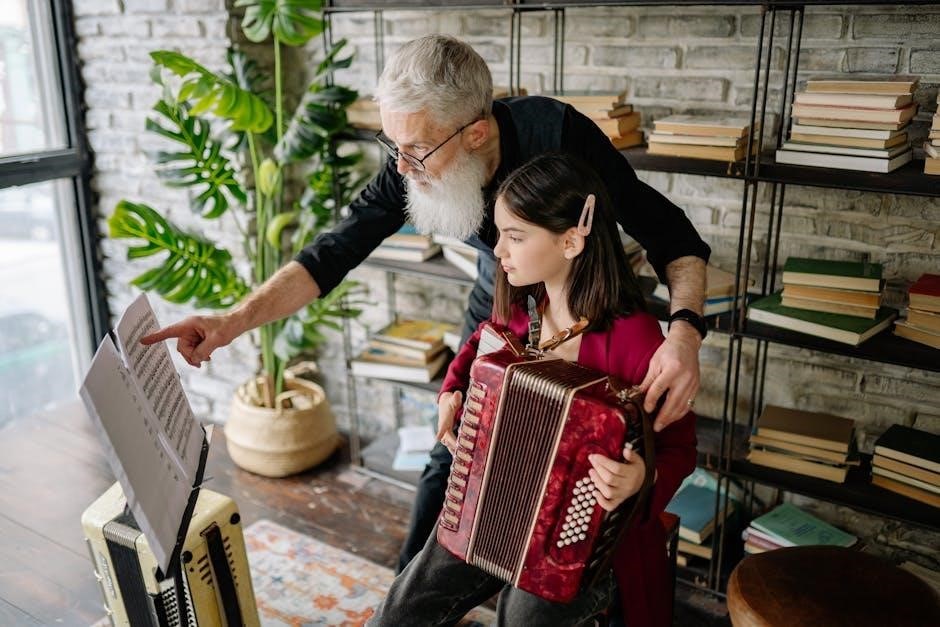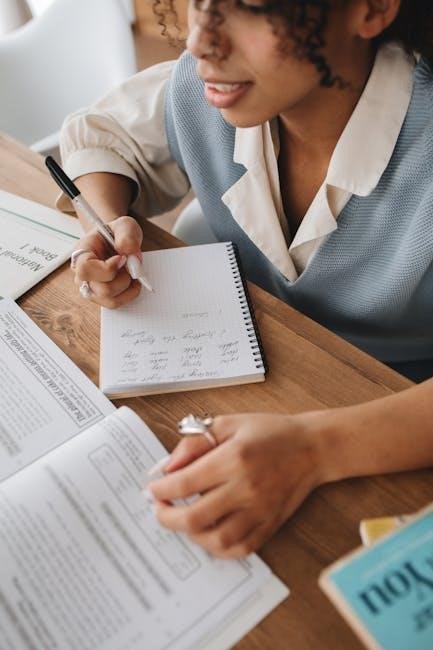learn to skate instructor manual
This manual serves as a comprehensive guide for instructors, providing essential tools and techniques to teach skating effectively․ It covers safety, skill progression, and class management strategies․
1․1 Purpose and Importance of the Manual
This manual is designed to provide instructors with a structured approach to teaching skating, ensuring consistency and effectiveness․ It offers guidance on safety, skill progression, and class management, helping instructors create a positive learning environment․ The manual is essential for both new and experienced instructors, serving as a valuable resource to enhance teaching methods and student outcomes․
1․2 Target Audience and Skill Levels
This manual is tailored for instructors teaching skaters of all ages and skill levels, from beginners to advanced learners․ It provides adaptable methods to accommodate diverse learning needs, ensuring each skater progresses at their own pace․ The content is structured to support instructors in creating engaging lessons for various groups, fostering a supportive and inclusive skating environment․

Understanding the Role of a Skate Instructor
A skate instructor is a guide and mentor, teaching techniques while building confidence and creating a supportive, enjoyable environment for skaters to grow․
2․1 Key Qualities and Skills of an Effective Instructor
An effective instructor possesses strong communication skills, patience, and the ability to break down techniques clearly․ They should be knowledgeable in skating fundamentals, adaptable to student needs, and able to create a positive, encouraging atmosphere․ Demonstrating techniques and providing constructive feedback are also essential for helping students progress and achieve their skating goals․
2․2 Building Confidence and Motivation in Students
Building confidence and motivation involves creating a supportive environment where students feel safe to attempt new skills․ Positive reinforcement, celebrating small successes, and setting achievable goals are key strategies․ Instructors should also adapt techniques to suit individual learning styles, ensuring each student feels valued and encouraged to progress at their own pace, fostering a lifelong love for skating․

Structuring a Learn to Skate Lesson Plan
A well-structured lesson plan ensures engagement and progress․ It includes clear objectives, warm-ups, skill demonstrations, practice time, feedback, and wrap-ups, fostering a logical flow for skill development․
3․1 Components of a Successful Lesson Plan
A successful lesson plan includes clear objectives, a structured warm-up, skill demonstrations, supervised practice, constructive feedback, and a cool-down․ Incorporating safety, drills, and varied activities ensures engagement․ Adjusting the plan based on student progress and feedback promotes effective learning and skill mastery, creating a balanced and productive skating session for all participants․
3․2 Progression of Skills: From Basic to Advanced
The progression begins with foundational skills like balance and stability, followed by basic movements such as gliding and stopping․ Intermediate skills include turning and crossovers, while advanced techniques involve jumps, spins, and complex footwork․ Each skill builds logically on the previous one, ensuring a smooth transition and mastery․ Instructors adapt the pace to suit individual student development, fostering confidence and technical proficiency․
Safety Measures and Emergency Preparedness
Ensure all skaters wear proper safety gear, including helmets and knee pads․ Conduct regular safety drills and maintain first aid kits․ Supervise students closely to prevent accidents and have emergency plans ready for quick response․
4․1 Essential Safety Equipment for Skaters
Skaters must wear helmets, knee pads, and elbow pads to protect against falls․ Wrist guards and supportive skating socks are also recommended․ Ensure all equipment fits properly and is checked regularly for wear․ Instructors should always supervise students to enforce safety protocols and address potential hazards promptly․ Proper gear and supervision are critical for a safe learning environment․
4․2 Handling Common Injuries and Emergencies
Instructors must be trained in basic first aid to address common injuries like bruises, sprains, and cuts․ Assess injuries promptly, apply the RICE method (Rest, Ice, Compression, Elevation), and seek medical attention if necessary․ Always have a first aid kit on hand and ensure emergency contact information is readily available․ Preparedness is key to ensuring student safety and well-being during lessons․

Teaching Fundamental Skating Skills
Mastering balance, movement, and control is essential for skaters․ Instructors should focus on breaking skills into manageable parts, ensuring students build confidence and proficiency step-by-step․
5․1 Balance and Stability Techniques
Balance and stability are foundational skills for skating․ Instructors should teach proper stance, posture, and weight distribution․ Drills like single-leg stands and T-drills enhance equilibrium․ Visual cues, such as keeping eyes forward, help students maintain focus․ Gradually introducing movements like gliding and shifting weight improves overall stability, building confidence for more advanced techniques․
5․2 Stopping and Turning: Basic and Advanced Methods
Teach basic stopping techniques like the “snowplow stop” and “hockey stop,” progressing to advanced methods such as edge stops․ For turning, start with stationary turns, then move to moving turns․ Advanced techniques include using body weight and arm movements for control․ Drills should focus on gradual skill progression, ensuring students master each step before advancing to more complex maneuvers․
Advanced Techniques for Experienced Skaters
Introduces advanced techniques such as jumps, spins, and complex footwork for experienced skaters․ Includes drills to enhance speed, agility, and control, preparing them for competitive or performance levels․
This section introduces advanced techniques such as jumps and spins, focusing on proper execution and safety․ It outlines the progression from basic to complex elements, ensuring skaters build a strong foundation․ Emphasis is placed on mastering each skill before advancing, with specific drills and exercises to enhance technique and control․ The manual provides detailed breakdowns of each jump and spin, offering tips on how to approach difficult movements and common mistakes to avoid, helping instructors guide students effectively in mastering these advanced skills․
6․2 Drills for Improving Speed and Agility
Drills such as interval training and zigzag skating help enhance speed and agility․ These exercises focus on quick turns, fast starts, and stops, improving skaters’ overall performance․ The manual provides structured drills to challenge skaters, ensuring they develop the necessary skills to excel in more advanced techniques while maintaining control and precision on the ice․
Effective Use of Drills and Exercises
This section outlines structured drills and exercises to enhance skating skills, focusing on balance, coordination, and endurance․ It emphasizes progressive techniques to build confidence and keep students engaged․
7․1 Balance and Coordination Drills
Drills focusing on balance and coordination are essential for skaters to master foundational skills․ These include stationary exercises like single-leg stands and dynamic drills such as weaving through cones or following patterns on the ice․ Progression from basic to advanced techniques ensures skaters build confidence and improve their ability to maintain stability while moving․ These exercises are vital for developing proper posture and overall skating efficiency․
7․2 Breathing and Switching Techniques for Endurance
Breathing and switching techniques are crucial for building endurance in skaters․ Proper breathing ensures oxygen flow, enhancing stamina, while switching techniques, such as alternating feet and directions, improve rhythm and control․ These methods help skaters maintain consistent performance during extended sessions, reducing fatigue and improving overall skating efficiency and endurance levels over time․ Regular practice of these techniques is highly recommended․

Class Management and Student Engagement
Effective class management ensures a productive and engaging learning environment․ Instructors should maintain optimal group sizes, encourage participation, and use positive reinforcement to keep students motivated and focused․ Proper organization and clear communication are key to fostering a positive and structured skating experience for all participants, promoting skill development and enjoyment․ Regular feedback and adaptability further enhance the learning process, ensuring each student’s needs are met and their progress is tracked effectively; By creating a supportive atmosphere, instructors can help students build confidence, improve their skills, and develop a passion for skating that extends beyond the classroom․
8․1 Managing Group Sizes and Coach-to-Student Ratios
Optimal group sizes and coach-to-student ratios are crucial for effective instruction․ Smaller groups ensure personalized attention, while larger groups can be managed with additional assistants․ Maintaining a balanced ratio allows instructors to demonstrate techniques, provide feedback, and monitor progress efficiently․ This setup promotes safer learning environments, better skill development, and increased student engagement, ensuring each skater receives the guidance they need to improve․ Proper management enhances overall learning outcomes and student satisfaction․
8․2 Keeping Students Motivated and Focused
Positive reinforcement, goal setting, and interactive drills are key to maintaining student motivation․ Celebrate small achievements to build confidence and encourage progression․ Vary exercises to keep lessons engaging and fun․ Use demonstrations and feedback to guide improvement․ Creating a supportive and dynamic environment helps students stay focused and eager to learn new skills, fostering a positive skating experience for all participants․
Continuous Development for Instructors
This section emphasizes the importance of ongoing education, workshops, and incorporating new techniques to enhance instructional skills and stay current with best practices in skating instruction․
9․1 Staying Updated with New Techniques and Research
Instructors should regularly attend workshops, webinars, and seminars to stay informed about the latest skating techniques and teaching methods․ Engaging with online resources, such as instructional manuals and research articles, ensures they remain current․ Participating in professional forums and networks also fosters collaboration and knowledge sharing, helping instructors refine their skills and deliver effective lessons․
9․2 Resources for Instructor Improvement
Instructors can benefit from various resources, including instructional manuals, online courses, and workshops․ Video tutorials and coaching clinics provide practical insights, while professional associations offer networking opportunities․ Accessing updated teaching materials and participating in mentorship programs further enhance skills, ensuring instructors deliver high-quality lessons and stay aligned with industry standards and best practices․
Community Involvement and Event Participation
Organizing fun skating events and competitions fosters community spirit and student engagement․ Instructors can collaborate with local organizations to host events, promoting skating and skill development․
10․1 Organizing Fun and Engaging Skating Events
Organizing fun and engaging skating events is crucial for building community spirit and keeping students motivated․ Instructors can plan themed sessions, games, and competitions that cater to all skill levels․ Incorporating activities like relay races and obstacle courses adds excitement while improving skills․ Such events also foster teamwork and confidence, helping students develop a lifelong passion for skating․
10․2 Preparing Students for Competitions and Performances
Preparing students for competitions and performances involves refining their skills, perfecting routines, and building confidence․ Instructors should focus on drills that enhance precision and artistry․ Providing constructive feedback and encouraging practice helps students excel․ Emphasizing mental preparation and performance strategies ensures they are ready to shine in front of an audience, fostering a sense of achievement and joy in skating․
Encourage a lifelong love for skating by fostering creativity, confidence, and joy․ Stay adaptable, continuously improve your skills, and inspire students to embrace the beauty of skating․
11․1 Summary of Key Principles
The manual emphasizes patience, clear communication, and tailored instruction․ It highlights the importance of safety, progressive skill development, and creating a supportive environment․ Instructors should focus on building confidence, encouraging creativity, and fostering a passion for skating․ Continuous learning and adaptability are crucial for effective teaching․ These principles ensure a well-rounded and enjoyable skating experience for all students․
11․2 Encouraging a Lifelong Love for Skating
Instructors play a vital role in fostering a lifelong passion for skating․ By creating a positive, supportive environment, they can inspire students to embrace challenges and celebrate progress․ Encouraging creativity, providing constructive feedback, and making lessons enjoyable helps students develop a deep appreciation for the sport, turning it into a rewarding and lasting hobby․